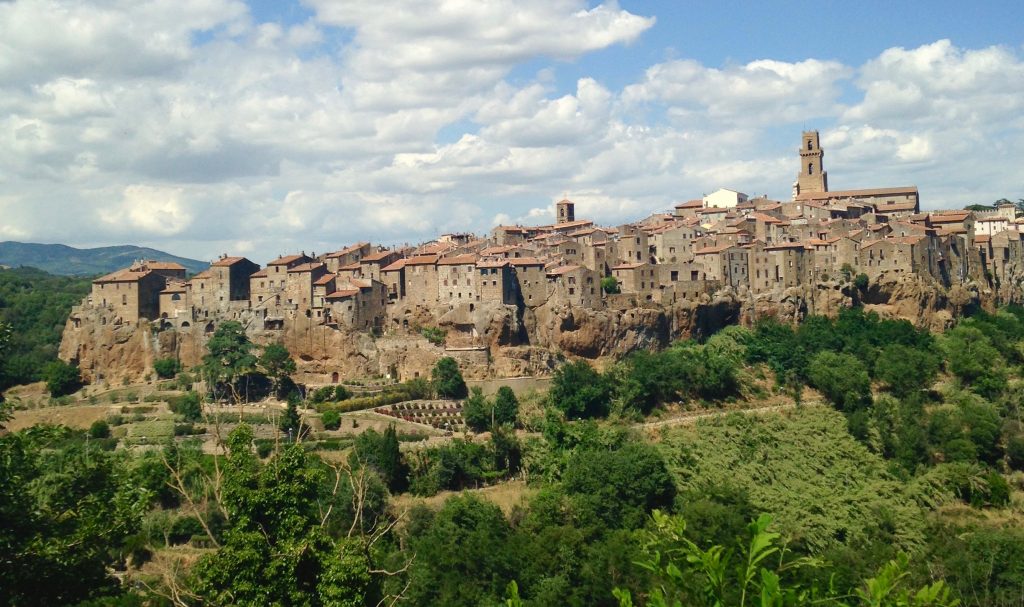The hilltop town of Pitigliano is one of the highlights of Southern Tuscany. A bewitching sight with a fascinating history.
Pitigliano strikes a strange figure on its rocky outcrop in the southern end of Tuscany. Undoubtedly one of the most curious looking walled towns in Tuscany, it’s set in the verdant countryside of the Maremma, halfway between Florence and Rome. It perches on a plateau surrounded by gorges – natural defences that are completed by an imposing fortress.

Etruscan sites in Pitigliano, Tuscany
Its houses seem to grow directly out of yellowish red volcanic tuff, which has been excavated since Etruscan time, and later used as refuges and wine cellars. Today, inside the town, there’s not much evidence of the Etruscan origins, apart from the small but nicely organised Archeological Museum in Palazzo Orsini. But the area surrounding it has plenty to offer visitors.
The necropolis of Sovana is the main Etruscan sight a few kilometers from Pitigliano, but the Museo all’Aperto Alberto Manzi of Pitigliano also offers an interesting glimpse into Etruscan culture.
You’ll love the town’s crumbling buildings, lovely small shops and medieval lanes that overlook the precipice.
Planning a trip to southern Tuscany? Check out our 4 day driving itinerary through the Maremma, that include Pitigliano, the walled village of Capalbio and scenic Mount Argentario,
What to see in Pitigliano Tuscany, Italy
Palazzo Orsini – The Orsini family, ruled over Pitigliano before the Medici took hold of it in 1562. They built a massive fortress in the 15th century, incorporating an older and much smaller structure. Its defensive character has been softened by the addition of Renaissance features like loggias and a grand inner courtyard. The Palazzo Orsini today hosts a 21 room museum (ranged over different levels, with many stairs to climb), that has a jumble of different objects and artefacts. The exhibition lacks explanatory detail, but it’s worth it to see the Palace itself.
The Archeological Museum on the other hand is well organised. It contains finds from local sites that are well displayed though explanations are in Italian only. It is also inside Palazzo Orsini.
The maze-like area around the ancient Jewish Ghetto quarter is particularly fascinating. In via Zuccarelli you’ll find the ‘LIttle Jerusalem’. This is a well kept museum that includes a synagogue, and ancient rooms excavated into the tufa rock that were used for the activities of the ghetto. A visit to the Jewish quarter offers an interesting insight into the life of the Jewish community in Pitigliano, that hosted an important Jewish community in central Italy.
=> Top 12 Hilltop Towns in Tuscany!

The 16th century aqueduct’s arches add to the town’s fantastical quality, especially at night when they are lit up, creating a surreal sight.
The monumental fountain “Fontana delle 7 cannelle” in Piazza della Repubblica, 16th century, used to be a public fountain.
San Rocco Church is the town’s oldest church whose Romanesque interior sports a handsome nave and aisles supported by travertine columns.
What’s nearby
Museo all’Aperto Alberto Mansi, just outside Pitigliano is a small necropolis. Pitigliano’s Via Cava (‘sunken road’ of Etruscan origin) is not long, but in great condition with a convenient handrail for those who need it.
“Tufa towns” Sorano and Sovana are close by, and are amongst the most scenic locations in the Maremma. If you visit them, you’ll find out more reasons to fall in love with this fascinating part of Tuscany.
If you like the idea of exploring small towns with an authentic Tuscan feel, check out our post about ten charming small towns in Tuscany.

